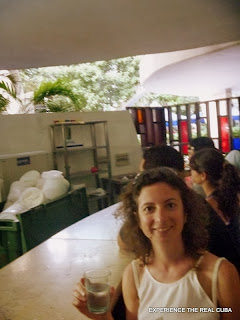The first time I took the Viazul bus in Cuba, I didn’t know what to expect. I had planned to spend a few days in Havana before going to Trinidad and I was keen to buy the bus ticket to Trinidad on my first day in Havana. At the Casa Particular in Havana, they told me it wasn’t possible to buy the bus ticket in advance and that it would be ok to turn up 1 hour before the bus departs and buy the ticket on the day. Off course I worried that the bus tickets would be sold out and that I wouldn’t get to Trinidad as planned, but I decided to put it to the back of my mind, to enjoy my 3 days in Havana and hoped for the best.
Even though I was staying in a Casa Particular in Vedado, the Casa recommended that I take a taxi to the Viazul bus terminal, it’s not within walking distance and I had no idea whether I could get a public bus to the terminal. When you ask a local about bus services in Havana they usually screw their nose up and tell you to get a taxi!
I got to the Viazul bus terminal at 7am as I wanted to get the 8am bus to Trinidad, so I queued up patiently and waited for the cubicle to open. It wasn’t totally obvious to me whether I was waiting in the right queue so I asked someone and they assured me I just had to wait.
Eventually the lady in the cubicle started selling tickets, it was a slow process, it felt like the Assistant had to make a telephone call with each customer to confirm something, I could hear a lot of paper shuffling and banging around. There was no air-conditioning at the ticket office and even though it was just after 7am the temperature was rising, I could feel drops of sweat running down my back where I was still wearing my small back pack on my back. I really wanted to get rid of all my bags, but I didn’t want to leave them unattended so I had left my large back pack resting on my legs, awkwardly having to shuffle it further towards the ticket office as each passenger bought their ticket.
When it was finally my turn I was relieved to find out that the tickets weren’t sold out. I had a clear view of the ticket office, there was no computer system instead there was a scrappy piece of paper with a list of names written illegibly, she added my name to the list, took my money, 25 CUC, and gave me a small piece of paper; this was my ticket! I couldn’t decipher whether I had been allocated a seat or not or from which gate the bus would be departing from. It amazed me how they could maintain some sense of order and organisation between all the various bus terminals and ticket agencies. This is probably why they had to make and receive frequent telephone calls between each other.
Once I had my ticket in my hand I went to look for the departure lounge and I was told that I would have to check-in my luggage. Part of me was glad to be free of my luggage, but the other part of me was nervous of letting it go. Would it be put on the right bus? Would I ever see my luggage again? Oh well, yet again I had to have faith and trust. My luggage was weighed, it was given a ticket and I was given the other half of the ticket, so I could collect my luggage at the other end.
The departure lounge wasn’t so busy, it was air-conditioned, there were a couple of stalls selling souvenirs / books in Spanish and there was a cafeteria upstairs where you could buy food and drink. About 15 minutes before departure I could see our luggage being loaded on the bus and we were called to board the bus shortly after. As it turned out seats were not assigned, so you could sit where you wanted and surprisingly the bus wasn’t even half full and it left on time.
The journey was pretty smooth it took around 5 hours. Before departing Havana the bus stopped at the Astro bus terminal near the Plaza de Independencia and picked up more passengers, it stopped half way through the journey for around 30 minutes where we could buy food and drink or use the bathroom facilities and it stopped for around 5 minutes in Cienfuegos to drop-off or pick-up passengers. It was like the Arctic inside the bus, the air-conditioning was a bit full on, but luckily I had plenty of layers.
The journey between Cienfuegos and Trinidad was beautiful, the Sierra de Escrambay mountains on one side and the ocean on the other. When Trinidad came into view I couldn’t help but feel excited, finally I had made it to Trinidad. My first impression was as I expected and more, bumpy cobbled streets and beautiful brightly painted colonial buildings, I couldn’t wait to get to know Trinidad. As for my luggage, there was nothing to worry about, it was on the bus, I paid 1 CUC tip to the guy pulling luggage off the bus and I headed to the crazy crowds in search of my host family.
The bus departs daily from Havana’s bus terminal to Trinidad, at approx. 8am and 1pm. Viazul do have a website but I have never attempted to book a ticket online, my faith hasn’t extended that far! But if you want to check out where the Viazul bus travels to, it’s departure times and prices you can check out their website at http://www.viazul.com/.
EXPERIENCE THE REAL CUBA – SUPPORTING CUBAN BUSINESSES





















